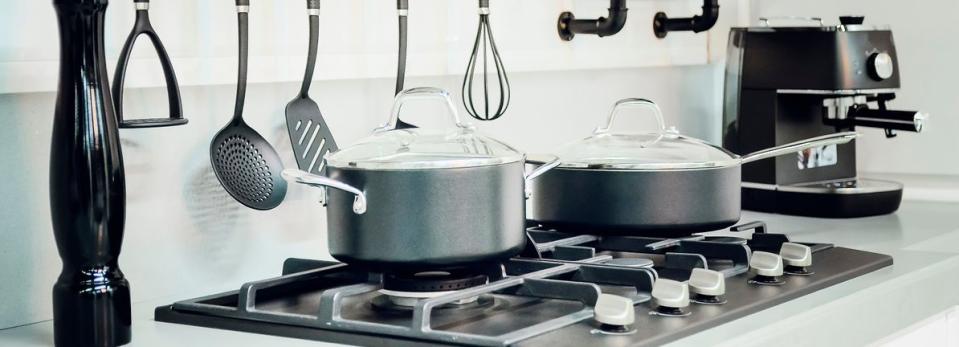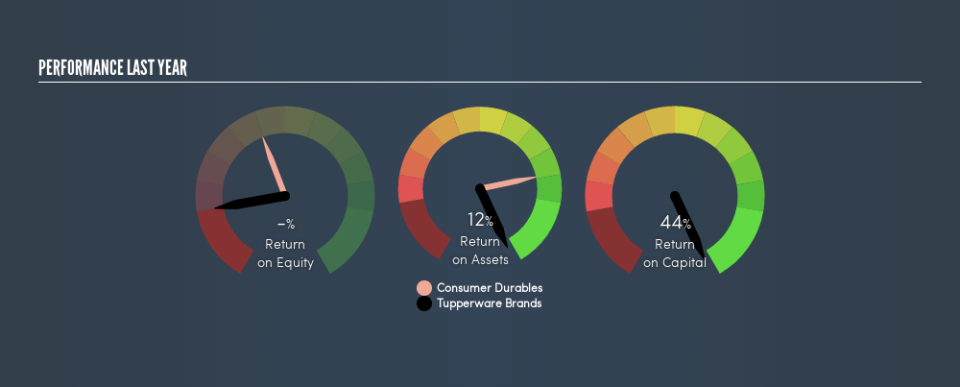Why Tupperware Brands Corporation’s (NYSE:TUP) Return On Capital Employed Is Impressive

Today we'll look at Tupperware Brands Corporation (NYSE:TUP) and reflect on its potential as an investment. Specifically, we'll consider its Return On Capital Employed (ROCE), since that will give us an insight into how efficiently the business can generate profits from the capital it requires.
First of all, we'll work out how to calculate ROCE. Second, we'll look at its ROCE compared to similar companies. And finally, we'll look at how its current liabilities are impacting its ROCE.
Understanding Return On Capital Employed (ROCE)
ROCE measures the amount of pre-tax profits a company can generate from the capital employed in its business. Generally speaking a higher ROCE is better. In brief, it is a useful tool, but it is not without drawbacks. Renowned investment researcher Michael Mauboussin has suggested that a high ROCE can indicate that 'one dollar invested in the company generates value of more than one dollar'.
How Do You Calculate Return On Capital Employed?
The formula for calculating the return on capital employed is:
Return on Capital Employed = Earnings Before Interest and Tax (EBIT) ÷ (Total Assets - Current Liabilities)
Or for Tupperware Brands:
0.44 = US$289m ÷ (US$1.4b - US$774m) (Based on the trailing twelve months to June 2019.)
Therefore, Tupperware Brands has an ROCE of 44%.
View our latest analysis for Tupperware Brands
Does Tupperware Brands Have A Good ROCE?
ROCE can be useful when making comparisons, such as between similar companies. In our analysis, Tupperware Brands's ROCE is meaningfully higher than the 11% average in the Consumer Durables industry. I think that's good to see, since it implies the company is better than other companies at making the most of its capital. Setting aside the comparison to its industry for a moment, Tupperware Brands's ROCE in absolute terms currently looks quite high.
We can see that , Tupperware Brands currently has an ROCE of 44% compared to its ROCE 3 years ago, which was 31%. This makes us think about whether the company has been reinvesting shrewdly. The image below shows how Tupperware Brands's ROCE compares to its industry, and you can click it to see more detail on its past growth.
It is important to remember that ROCE shows past performance, and is not necessarily predictive. ROCE can be deceptive for cyclical businesses, as returns can look incredible in boom times, and terribly low in downturns. ROCE is, after all, simply a snap shot of a single year. Since the future is so important for investors, you should check out our free report on analyst forecasts for Tupperware Brands.
Do Tupperware Brands's Current Liabilities Skew Its ROCE?
Current liabilities are short term bills and invoices that need to be paid in 12 months or less. Due to the way ROCE is calculated, a high level of current liabilities makes a company look as though it has less capital employed, and thus can (sometimes unfairly) boost the ROCE. To check the impact of this, we calculate if a company has high current liabilities relative to its total assets.
Tupperware Brands has total assets of US$1.4b and current liabilities of US$774m. As a result, its current liabilities are equal to approximately 54% of its total assets. Tupperware Brands's high level of current liabilities boost the ROCE - but its ROCE is still impressive.
The Bottom Line On Tupperware Brands's ROCE
So to us, the company is potentially worth investigating further. Tupperware Brands shapes up well under this analysis, but it is far from the only business delivering excellent numbers . You might also want to check this free collection of companies delivering excellent earnings growth.
For those who like to find winning investments this free list of growing companies with recent insider purchasing, could be just the ticket.
We aim to bring you long-term focused research analysis driven by fundamental data. Note that our analysis may not factor in the latest price-sensitive company announcements or qualitative material.
If you spot an error that warrants correction, please contact the editor at editorial-team@simplywallst.com. This article by Simply Wall St is general in nature. It does not constitute a recommendation to buy or sell any stock, and does not take account of your objectives, or your financial situation. Simply Wall St has no position in the stocks mentioned. Thank you for reading.

 Yahoo Finance
Yahoo Finance 
